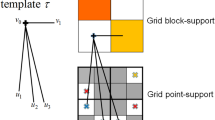Abstract
A novel grid-free geostatistical simulation method (GFS) allows representing coregionalized variables as an analytical function of the coordinates of the simulation locations. Simulation on unstructured grids, regridding and refinement of available realizations of natural phenomena including, but not limited to, environmental systems are possible with GFS in a consistent manner. The unconditional realizations are generated by utilizing the linear model of coregionalization and Fourier series-based decomposition of the covariance function. The conditioning to data is performed by kriging. The data can be measured at scattered point-scale locations or sampled at a block scale. Secondary data are usually used in conjunction with primary data for the improved modeling. Satellite imaging is an example of exhaustively sampled secondary data. Improvements and recommendations are made to the implementation of GFS to properly assimilate secondary exhaustive data sets in a grid-free manner. Intrinsic cokriging (ICK) is utilized to reduce computational time and preserve the overall quality of the simulation. To further reduce the computational cost of ICK, a block matrix inversion is implemented in the calculation of the kriging weights. A projection approach to ICK is proposed to avoid artifacts in the realizations around the edges of the exhaustive data region when the data do not cover the entire modeling domain. The point-scale block value representation of the block-scale data is developed as an alternative to block cokriging to integrate block-scale data into realizations within the GFS framework. Several case studies support the proposed enhancements.
























Similar content being viewed by others
References
Babak O (2008) Theoretical and practical improvements to geostatistical estimation and simulation. PhD Thesis, University of Alberta
Babak O, Machuca-Mory DF, Deutsch CV (2010) An approximate method for joint sequential simulation of multiple spatial variables. Stoch Environ Res and Risk Assess 24:327–336
Barnett RM, Deutsch CV (2015) Multivariate imputation of unequally sampled geological variables. Math Geosci. (online publication)
Barnett RM, Manchuk JG, Deutsch CV (2014) Projection Pursuit Multivariate Transform. Math Geosci 46(3):337–359
Bellin A, Rubin Y (1996) HYDRO_GEN: a spatially distributed random field generator for correlated properties. Stoch Hydrol Hydraul 10:253–278
Capilla JE, Rodrigo J, Gómez-Hernández JJ (1998) Worth of secondary data compared to piezometric data for the probabilistic assessment of radionuclide migration. Stoch Hydrol and Hydraul 12:171–190
Chiles JP, Delfiner P (2012) Geostatistics: modeling spatial uncertainty, 2nd edn. Wiley, New York
Deutsch CV, Journel AG (1998) GSLIB: Geostatistical Software Library and User’s Guide, 2nd edn. Oxford University Press, New York
Emery X (2010) Multi-Gaussian Kriging and simulation in the presence of an uncertain mean value. Stoch Environ Res Risk Assess 24:211–219
Goldberger AS (1964) Econometric theory. Wiley, New York
Goovaerts P (1997) Geostatistics for natural resources evaluation. Oxford University Press, New York
Gutjahr B, Bullard B, Hatch S, Hughson L (1994) Joint conditional simulations and the spectral approach for flow modeling. Stoch Hydrol Hydraul 8:79–108
Hughson DL, Yeh TCJ (1998) A geostatistically based inverse model for three-dimensional variability saturated flow. Stoch Hydrol Hydraul 12:285–298
Journel AG (1974) Geostatistics for conditional simulation of ore bodies. Econ Geolog 69(50):673–687
Journel AG, Huijbregts CJ (1978) Mining Geostatistics. Academic Press, New York
Leuangthong O, Deutsch CV (2003) Stepwise conditional transformation for simulation of multiple variables. Math Geol 35(2):155–173
Ostrouchov G, Doll WE, Beard LP, Morris MD, Wolf DA (2009) Multiscale structure of UXO site characterization: spatial estimation and uncertainty quantification. Stoch Environ Res Risk Assess 23:215–225
Pyrcz MJ, Deutsch CV (2014) Geostatistical reservoir modeling, 2nd edn. Oxford University Press, New York
Roberts BL, McKenna SA (2009) The Use of secondary information in geostastical target area identification. Stoch Environ Res Risk Assess 23:227–236
van de Kassteele J, Koelemeijer BA, Dekkers ALM, Schaap M, Homan CD, Stein A (2006) Statistical mapping of PM10 concentrations over Western Europe using secondary information from dispersion modeling and MODIS satellite observations. Stoch Environ Res Risk Assess 21:183–194
Vargas-Guzman JA (2003) Conditional components for simulation of vector random fields. Stoch Environ Res Risk Assess 17:260–271
Wackernagel H (2003) Multivariate geostatistics: an introduction with applications, 3rd edn. Springer, Berlin
Xu H, Xu CY, Sælthun NR, Zhou B, Xu Y (2014) Evaluation of Reanalysis and Satellite-based Precipitation Datasets in Driving Hydrological Models in a Humid Region of Southern China. Stoch Environ Res Risk Assess (online)
Zagayevskiy Y, Deutsch CV (2015) Multivariate geostatistical grid-free simulation of natural phenomena. Math Geosci (under review)
Acknowledgments
The authors would like to express gratitude to the sponsoring companies of the Centre for Computational Geostatistics (CCG) for their financial support.
Author information
Authors and Affiliations
Corresponding author
Rights and permissions
About this article
Cite this article
Zagayevskiy, Y., Deutsch, C.V. Multivariate grid-free geostatistical simulation with point or block scale secondary data. Stoch Environ Res Risk Assess 30, 1613–1633 (2016). https://doi.org/10.1007/s00477-015-1154-x
Published:
Issue Date:
DOI: https://doi.org/10.1007/s00477-015-1154-x




